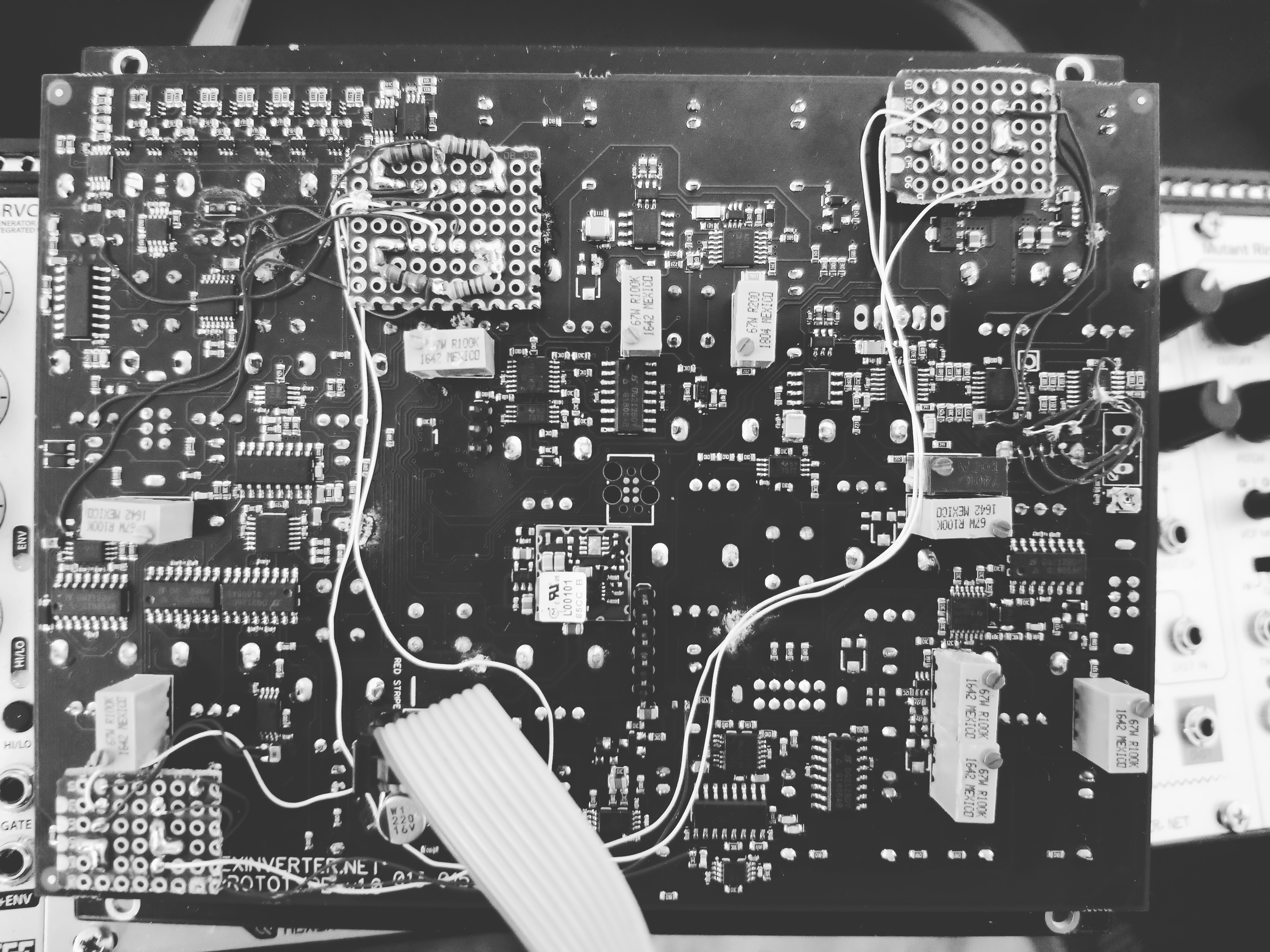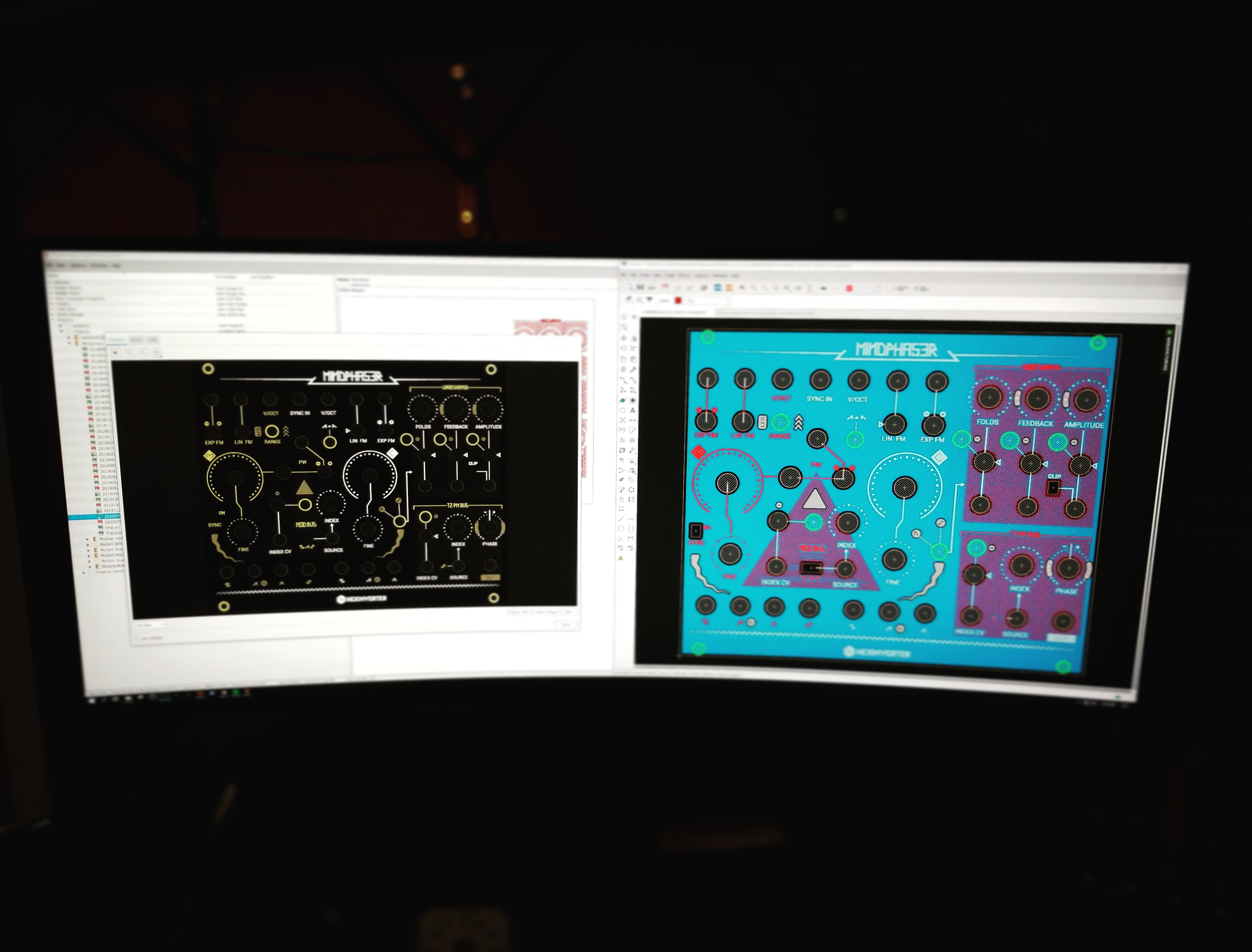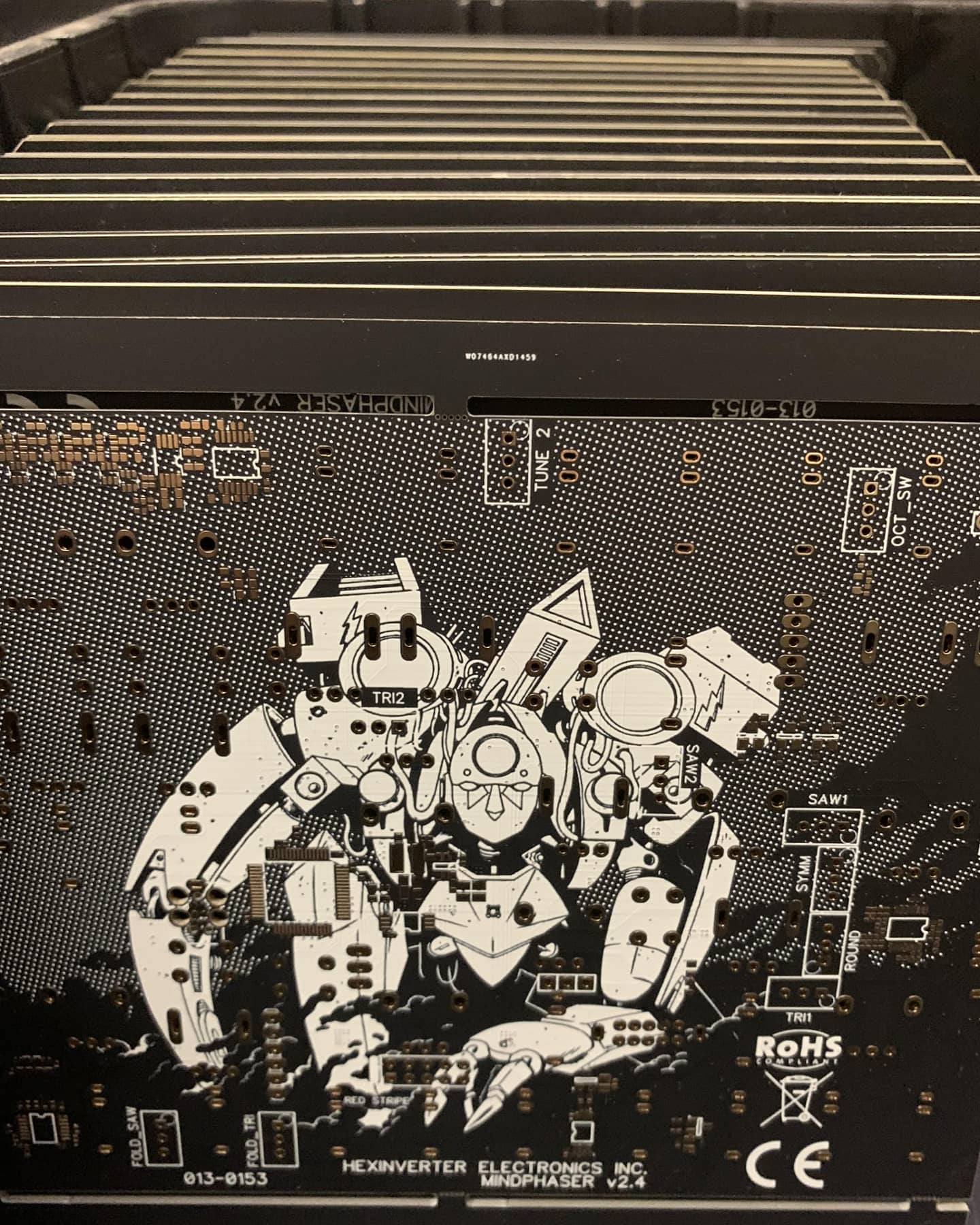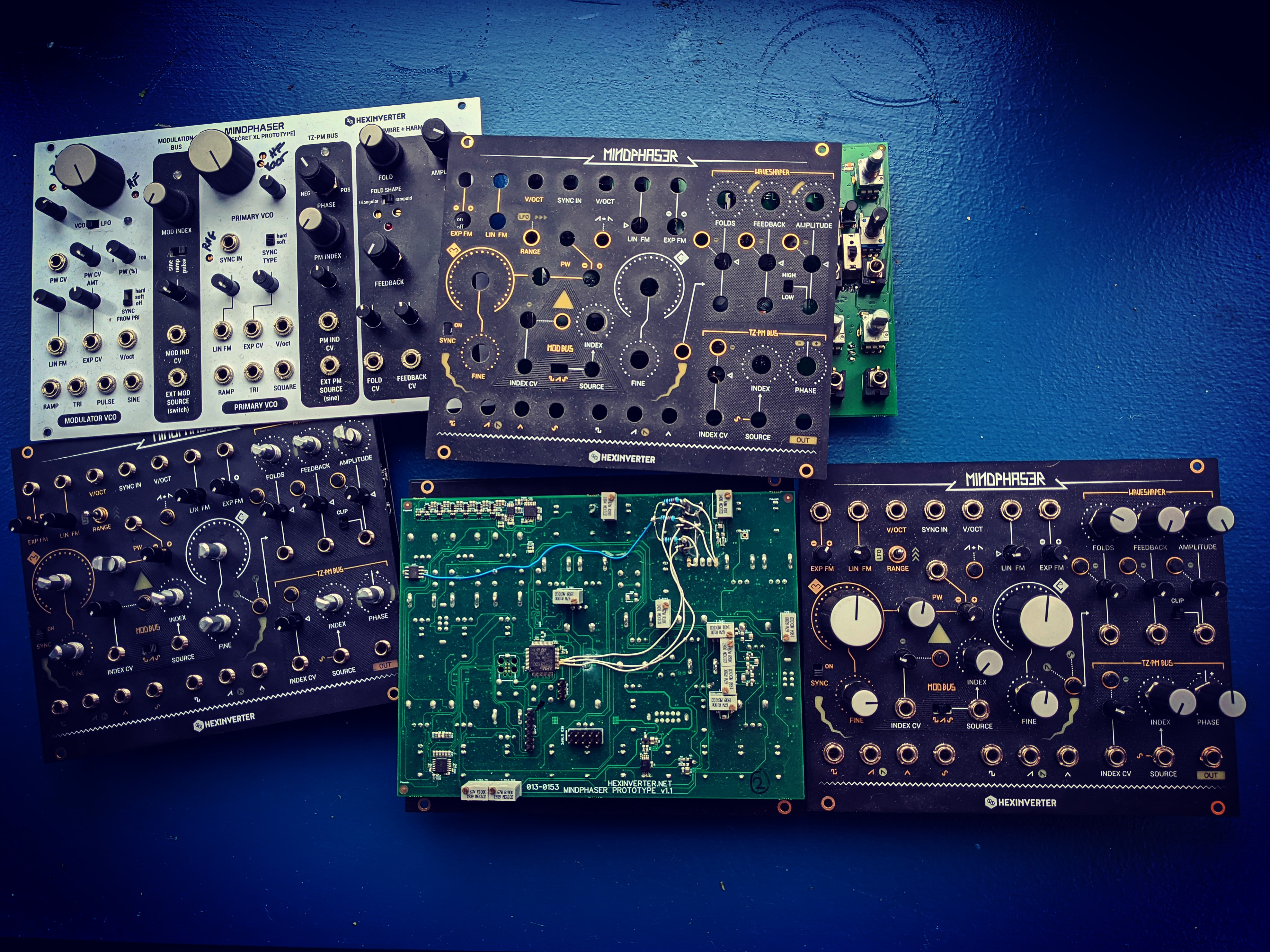Among many Eurorack manufacturers Hexinverter always stands out—offering some of the most unique solutions for modular percussion instruments (Mutant series), a characterful filter (Red Dragon), and a favorite endlessly flexible MIDI-to-CV utility (Mutant Brain). It wouldn't be an overstatement to say that every new release from the brand is much anticipated here at Perfect Circuit, and for quite awhile now we have been patiently waiting for the long-announced Mindphaser—a complex oscillator with some truly exceptional features, and from what we have heard, an equally extraordinary sound.
Well, the time has finally come, and Mindphaser is finally a reality. Full of excitement, we decided to get in touch with Stacy Gaudreau—the mind behind Hexinverter—to chat about the evolution of the Mindphaser module, company's background, and his ideas and philosophies concerning the world of synths.
Inception
Eldar Tagi: Hey Stacy. Thank you for chatting with us. Let's start at the beginning. Can you please tell us a little bit about your background, and how did you get into designing and building modules?
Stacy Gaudreau: I’ve always had a fascination with electronic devices and their inner-workings. Sometime in my single digits, my mother would set aside some cash to let me buy whatever I wanted at the thrift store (back when they were not in vogue, and things were actually dirt cheap). I’d come home with a tape deck or two, or a VCR, and spend my time taking it apart. It wasn’t particularly constructive, but I loved it.
A love for electronic music followed years later. One day on the bus to school, a stranger started talking to me about my goth rock/synth band after taking notice of the Skinny Puppy patch on my bag. Looking back, I probably would also have been intrigued by a kid dressed in a long black trench coat, with a Bites-era Skuppy patch on. Especially in small town Winnipeg, MB.
It turns out that stranger was an avid modular synth musician and DIY builder. He showed me photos of the massive 5U modular he’d built and told me about kit building on the weekend. I knew I wanted to get into it, but there was no way I could afford it yet.
Years later, when I had two coins of my own to rub together, I began DIYing and building synthesizers. I’d learned a lot from electronics class in high school (which aside from programming class, was just about the only class I cared enough for to attend regularly).
I was in university for electrical engineering when the synthesizer stuff began. We started with an online shop that sold DIY circuit boards and kit products, and this quickly grew into building eurorack modules as the format was really taking off.
Around that time, I dropped out of engineering school as things were beginning to snowball, and the rest has kind of just been a big ride!
Designing Eurorack Modules

ET: What attracts you to the Eurorack format over standalone devices, and other modular formats?
SG: At the time we started designing eurorack modules, it seemed like a very favourable format to come up with wacky ideas for. Compared to the more modest realm of 4U -- and even more so, 5U -- it felt a bit like the “wild west” of modular. We may have zillions of modules today, but back then -- it used to be that nearly half of the ideas for modules which popped into my head had not even been realised in the format yet.
At first I hated the non-homogenous mess of panel aesthetics in a single eurorack system (coming from building 4U stuff) -- and don’t even get me started on the electrical issues.
The mess of aesthetics has grown on me in time, though.
ET: How has the growth of the Eurorack market affected your work? Do you find it more difficult to come up with ideas or does the abundance inspire you?
SG: Coming up with original ideas which pass the “but is it a viable product?” test has certainly become more challenging in recent years. There are just so many modules now, it can be a bit dizzying! There was a time when we put out two new releases in a year, but I think those days are behind us.

ET: What is the most challenging part of designing a module for you? As an extension of this question, what Hexinverter module was the most difficult to realize for you?
SG: The design process always has its unexpected twists, and nearly every module is a totally new learning experience for me in terms of advancing electronic design or embedded skills. Scaling back feature-set to something affordable for people and which will fit into the very limited panel space of eurorack is always a major challenge!
Very rarely is the first concept for a Hexinverter module the same as the end product we release.
Hannes from Papernoise has been working with me from the early beginning, and has been a major help with the UI side of the design process. Besides providing the super cool illustrations and other graphics you may have seen, he’s had a growing involvement in developing the user experience of Hexinverter modules over the years.
Without a doubt, Mindphaser has been the most difficult one, yet. The journey seemed plagued with plot twists and road blocks for some time, in addition to my underestimation of how long it would take to get right. Thankfully, Hannes was up for it, and worked through the numerous panel iterations and concepts over the years it was in development. I’m also fortunate to have had the ear of a talented engineer and an amazing production team over at WMD to assist through some of the later obstacles, especially in regards to manufacturing.
ET: What is the most fulfilling and exciting part of that process? As an extension of this question, what is your favorite Hexinverter module?
SG: It will always be super exciting to stuff a concept module into the case, and have real knobs and patch points to play with as you see the idea in the flesh for the very first time.
Though perhaps the most fulfilling part of the journey is learning new stuff. Electronics design is a vast and nearly infinite world of things to discover and learn. There are certainly not enough hours in my lifetime to discover every interesting thing in the field.
ET: When designing modules, do you tend to have a specific sonic aesthetic in mind, or is your goal to make tools that are more universal?
SG: Perhaps someone will disagree with me, but I think Hexinverter’s sound can be pretty opinionated. Try as I may sometimes, I can’t really help wanting to unearth atypical sounds when I’m working on a design. It probably has a lot to do with the electronic music that really opened my eyes. Chief of which were Skinny Puppy, Front Line Assembly, Front 242 and the like as soon as I was old enough to appreciate it. I think that had something to do with the controls on our modules going up to 12 -- instead of 10 -- or 11 (grin).
ET: A good amount of modules you designed are dedicated percussion and drum modules (Mutant series). What, in your opinion, are the benefits of creating drum parts in modular format over stand-alone drum machines?
SG: A theme which is perhaps common to all modular, I would say, is: tactility. I’d argue that having a tactile instrument is one of the biggest draws to modular systems in general. You can noodle and “play” percussion modules with your fingers -- just like any other module.
In the case of Mutant Drums, I wanted their design to invite experimentation outside of classical percussion sounds as well. Perhaps even making sounds that are not percussion. Some of the Mutant Drums make excellent wobbly techno basslines, for example! That’s something you really cannot do with a drum machine. At least usually, not without doing some pretty major surgery on it (think Devilfish-style 303 mods).
ET: Unlike other instruments (including other modular formats), Eurorack seems to be a music tool that is constantly in a state of flux. Do you think such a thing as a perfect Eurorack system exists? If so, how do you see it?
SG: Definitely in agreement there; it’s in a total state of flux! I’m not sure if a perfect eurorack system exists (or ever will exist). But if it did, I think there would be far more mix sculpting tools present, like we have in modern recording systems. Even if they’re digital under the hood, a knob-per-function tactile feel would be more inviting than a computer screen. For me, currently, the best eurorack setup merges the two paradigms nicely -- and I think the Mutant Brain has been a good stepping stone for use with a contemporary studio -- but it would be great to have more mix and effect style utility modules within the format itself.

The Mindphaser
ET: Let's talk about your newest module, the long-awaited Mindphaser. Can you tell us what it is and what sets it apart from other complex oscillators, both in terms of functionality and sound?
SG: Mindphaser is the complex oscillator that I wanted all of the other ones that travelled through my case to sound more like. Not that any of them sounded bad -- quite the opposite! -- but I sometimes had trouble finding those really weird, vocal biting sounds out of them that I was hoping for.
Functionally, I don’t think there’s anything else quite like it. That might be good or bad to you -- depending on your taste (grin). It’s hard to talk about it without mentioning the phase modulation, which is entirely analog and happens inside the waveshaper (and not the VCO cores). It can be gnarly and glitchy sounding, which may come as a bit of a surprise to some since we often associate that kind of sonic characteristic with digital oscillators. Besides that, the waveshaper controls themselves bring it even further - feedback and overdrive within the folder, and a final clipping stage in the amplitude modulation stage. It can get nasty really fast and there’s weird stuff abound!
ET: It has been about two years since you initially announced Mindphaser. Can you speak about the particular challenges that delayed production of the module?
SG: I’m going to go ahead and tell myself that it was only two years, now that you put it out there (grin).
Some may recall, the original concept and first prototype made use of the CEM3340 reissues for the VCO cores. This turned out to have a number of challenges, as they were never really meant to be free-running in an analog system, but rather, work much better under digital control (like in a keyboard). They were hardly anywhere near as stable as a pretty standard modern VCO, and had a host of other issues in this particular design. In the end, I went back to the drawing board for the cores, and this took quite some time to sort out. There was also a lot of panel and UI iteration which was slow going largely in part due to needing to get it right!
 Several Mindphaser prototypes side by side
Several Mindphaser prototypes side by side
Defining a new panel aesthetic and incorporating the illuminated glyphs you see on the front panel was a slow process as well.
It would be a lie if I did not say there was more at play with the setbacks than just the massive scope of design-related challenge which we unearthed with the project. In the time since Mindphaser was announced, we moved out of the big city into a house in the country. Following that, a couple of years later we went back to being a one person company again, sort of like it was back in the beginning. The transition to that point hit me unexpectedly hard on a personal level, and I was finding it difficult to persevere with projects -- including Mindphaser -- for a while.
Much of the time around all that has been spent learning how to operate solo again, and it’s been more of a challenge than I had expected at times!
Future Plans and Words of Advice
ET: Do you have any plans for branching out of Eurorack into standalone instruments?
SG: There have been some good ideas in regards to that floating around here for some time. Perhaps if we had not spent so long on Mindphaser the past while, there would already be something mentionable in the works.
ET: What advice would you give to someone just getting started with modular?
SG: I’d probably encourage them to skip most if not all of the modules with deep menus on them. Especially anything with a big LCD display, or heaven forbid: a touch screen interface (gasp!). The best way to get stuck in with modular is to not have to look at a manual more than once or twice when you’re learning the module, and I think that comes best from knob-per-function designs.
ET: What do you think the future of music technology holds? What instruments / devices do you envision for the shape of electronic music to come?
SG: In terms of my own vantage point, one thing that I feel eurorack has been responsible for is the maturation of the modular system into a viable performance instrument. One that people carry on stage and make awesome music with, in a live setting. Yes, some people did manage to perform with modular before eurorack truly took off. However, when I started doing this stuff, it was mostly a bunch of studio-bound composers and hobbyists collecting the stuff.
To me it feels like there is still a way to go in terms of maturing the vision of performance electronic instruments. Where we’re going, I’m not exactly sure, but I think that we’ll continue to see improvements and invention in music technology that appeal to live electronic music performance.












